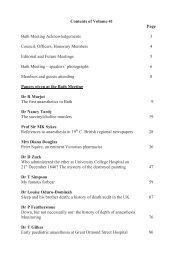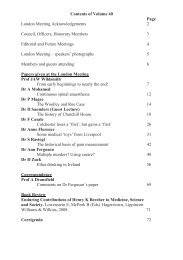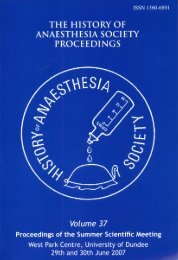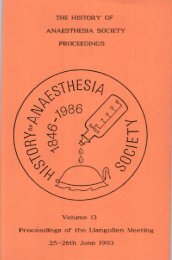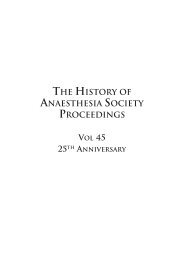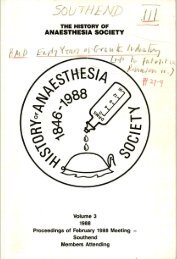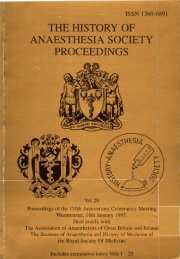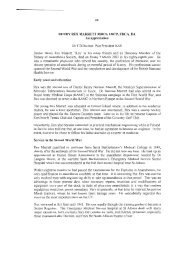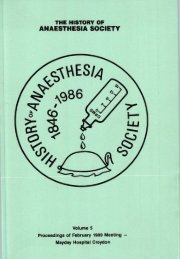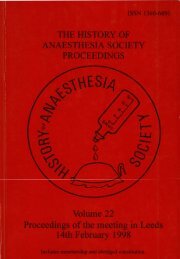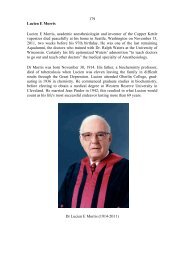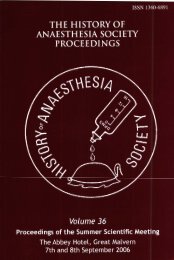Volume 7 - History of Anaesthesia Society
Volume 7 - History of Anaesthesia Society
Volume 7 - History of Anaesthesia Society
You also want an ePaper? Increase the reach of your titles
YUMPU automatically turns print PDFs into web optimized ePapers that Google loves.
1ME EARLY WYS OF CARDIAC<br />
I was involved with cardiac anaesthesia from 1949 to 1980, but feel I<br />
ought to mention sane <strong>of</strong> the more important events prior to these dates,<br />
because the developnents in cardiac surgery and anaesthesia were closely<br />
related.<br />
'he first operation on the heart took place in 1896 when the cardiac<br />
muscle was sutured following injury. In 1901 the first two successful<br />
cases <strong>of</strong> cardiac massage occurred - each by diEferent routes. Arbuthnot<br />
Lane in this country was operating on a man <strong>of</strong> 65 for appendicitis under<br />
ether anaesthesia when arrest occurred. He massaged the heart through<br />
the abdomen without opening the diaphragm. In the same year a surgeon<br />
in Norway was carrying out a hysterectomy on a 38 year old women under<br />
chlor<strong>of</strong>orm anaesthesia when she arrested. He made an intercostal<br />
incision and massaged the heart under direct vision.<br />
In 1929 Cutler and ~eck' reported 12 cases worldwide <strong>of</strong> operations on<br />
heart valves with only two successful results. The first two were in<br />
Paris in 1913 and 1914 when Doyen operated on a pulmonary valve and<br />
Tuffier on an aortic. The other ten were mitrals. All these patients<br />
breathed spontaneously and anaesthesia varied from open ether on a<br />
Schimnelbusch mask to nitrous oxide, oxygen, ether either with a face<br />
mask or insufflation through an intratracheal catheter as described by<br />
Kelly in 1912. Souttar's case, which was included in the series, was<br />
slightly different.<br />
On 6 May 1925 at the London Hospital, Henry Souttar operated on a girl<br />
<strong>of</strong> 14 with a diagnosis <strong>of</strong> severe mitral stenosis. He carried out the<br />
first transauricular approach to the mitral valve and the patient<br />
survived a further 7 years. Maurice ~am~bell,~ a cardiologist writing<br />
in the British Heart Journal in 1965 stated that the patient's survival<br />
was probably largely due to the skill <strong>of</strong> the young anaesthetist - John<br />
Challis. Until 1975 most people believed this, but in that year, to<br />
celeb ate the Eiftieth anniversary <strong>of</strong> Souttar' S operation, Dr Richard<br />
Ellis' <strong>of</strong> St Bartholomew's Hospital published in 4naesthesis1 a<br />
detailed account <strong>of</strong> the case. From the original notes it was quite<br />
clear that no anaesthetist was involved! In fact, the anaesthetic was<br />
administered by i-4~ Lindsay, a surgical colleague <strong>of</strong> Souttar's, assist&<br />
by a surgical registrar. 'he patient was prsmedicated with morphia and<br />
atropine, and induced with an A.C.E. (absolute aLcohol, chlor<strong>of</strong>orm,<br />
ether) mixture on a Schimnelbusch mask. <strong>Anaesthesia</strong> was deepened with<br />
ether, an intratracheal catheter inserted, and this connected to a<br />
shiPay4 apparatus, which delivered by insuEfLation a mixture <strong>of</strong> warm<br />
air and ether. The patient, <strong>of</strong> course, breathed spontaneously<br />
throughout. Shipway produced his original apparatus in 1916, but on his<br />
Latest model insufflation pressure could be varied - no doubt, a help<br />
with the open chest.



